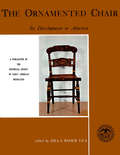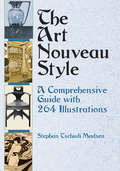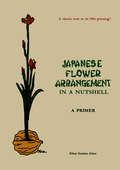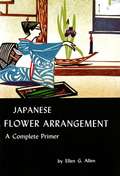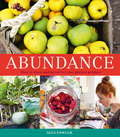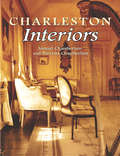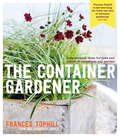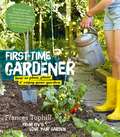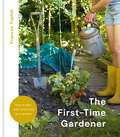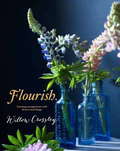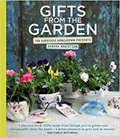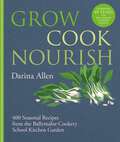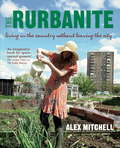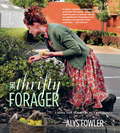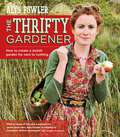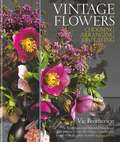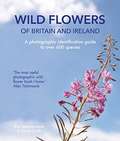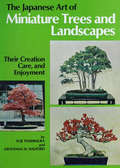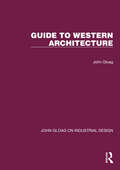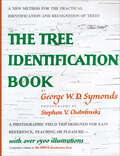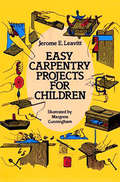- Table View
- List View
The Ornamented Chair
by Zilla Rider LeaDiscriminating decorators and collectors, no less than dealers and researchers in antiques, have long felt the need of a comprehensive study of the ornamented chair and its development in America. This book is the product of an effort to satisfy that need and at the same time to bring new pleasures to lovers of beautiful furniture.The book is based on photographic and research material collected by the late Esther Stevens Brazer, who spent a lifetime in the study and revival of early American decoration.The authors are all qualified researchers, teachers, and decorators. In their text they present a general history of chair types, facts regarding ornamentation, and informative accounts of some of the leading craftsmen and decorators of the various periods. The final chapter of the book briefly relates the history of the Society and describes how its members carry forward the efforts of Esther Stevens Brazer, maintaining in their research, their teaching, and their restorations the standards of an old craft and the traditions of its finest workmen.
The Ornamented Chair
by Zilla Rider LeaDiscriminating decorators and collectors, no less than dealers and researchers in antiques, have long felt the need of a comprehensive study of the ornamented chair and its development in America. This book is the product of an effort to satisfy that need and at the same time to bring new pleasures to lovers of beautiful furniture.The book is based on photographic and research material collected by the late Esther Stevens Brazer, who spent a lifetime in the study and revival of early American decoration.The authors are all qualified researchers, teachers, and decorators. In their text they present a general history of chair types, facts regarding ornamentation, and informative accounts of some of the leading craftsmen and decorators of the various periods. The final chapter of the book briefly relates the history of the Society and describes how its members carry forward the efforts of Esther Stevens Brazer, maintaining in their research, their teaching, and their restorations the standards of an old craft and the traditions of its finest workmen.
The Art Nouveau Style: A Comprehensive Guide with 264 Illustrations
by Stephan Tschudi MadsenA revolutionary reaction to traditional nineteenth-century art, the turn-of-the-century Art Nouveau movement drew much of its inspiration from nature. Applying its sinuous, curvilinear motifs to the decorative arts, graphics, architecture, sculpture, and painting, artists and craftspeople attempted to create a style suitable for a "modern" age. In this absorbing, exceptionally detailed, and well-researched book (one of the first scholarly works to revive interest in the style after World War II), a noted Norwegian authority on the subject examines the movement in depth. Stephan Madsen offers a wealth of facts and insights about the origins and development of the style; trends leading up to Art Nouveau, including the influence of Blake and the Pre-Raphaelites; early Art Nouveau posters and book illustrations; and its use in architectural ornamentation, furniture, jewelry, wrought-iron, glass, and other applied arts. A magnificent selection of 264 photographs and line drawings accompanies the text, which gives broad coverage to the movement, as well as insightful discussions of such important artists as Emile Gallé, Alphonse Mucha, Walter Crane, Charles Rennie Mackintosh, Aubrey Beardsley, Henry Van de Velde, Victor Horta, William Morris, and Eugène Grasset.Artists and students, admirers of Art Nouveau, and anyone interested in this enduring and influential style will welcome Professor Madsen's expert, fully documented study.
Japanese Flower Arrangement: A Primer
by Ellen Gordon AllenThis Japanese gardening book is a practical, concise guide to flower arranging or Ikebana.Illustrated with dozens of helpful photographs and diagrams, this flower arranging handbook provides full and comprehensive treatment of the various forms of Moribana and Heiki style arrangements. <P><P>Each lesson is given in detail step by step with accompanying sketches, showing clearly what should be done as the arrangement progresses towards completion. The photographs of actual completed flower arrangements sum up beautifully the principles underlying each particular style.The purpose of this text is to acquaint the reader with elementary knowledge in a special school of flower arranging-the Japanese school-selected because it is the oldest and its teachings are perhaps the simplest, yet most effective. The text is intended for amateurs, but professional arrangers might find it useful as a refresher.
Japanese Flower Arrangement: A Complete Primer
by Ellen G. AllenThere is something of the artist in each of us. Some of us find expression in painting, poetry, or sculpture, some in landscape gardening. With talent and facility, expression in these art forms is Satisfying. <P><P>And this is true also of flower arranging, an ancient art that can express a thought or mood and in a sense combine the expression of severnl other media. Yet special talent for flower arranging is not essential. The 'feeling' for it is engendered by the practice of it!' With these words Ellen Gordon Allen begins the introduction to her eminently practical primer of Japanese flower arrangement, which is here being offered in a new revised edition. As a certified teacher (Oharn school)and a very successful one, Mrs. Allen is well qualified to present her subject.The purpose of her book is fourfold: to increase the skill of all who love to arrange flowers to provide a more comprehensive understanding of the Japanese art of flower arrangement; to help students when no teacher is available; andto provide a medium of instruction among the many, often confusing, schools of Japoncse flower arrangement. It is Mrs. Allen's hope that the primer will serve as a practical handbook for beginners and that it will dispel the aura ofmystery that seems to surround the subject. To this end, she has made her instructions as elementary as possible. The few fundamental rules of Japanese flower arrangement and the various techniques are presented in a simple manner.Wherever possible, English equivalents have been substituted for Japanese terms. Each lesson sketches, photographs, and diagrams which clearly show the student what to do in working toward completion of the arrangement. Although Mrs. Allen teaches principally the methods of the Ohara school for the moribana and heika styles and the methods of the Saga school for the seika style, her book is also a compilation of information from the Sogetsu, the Ikenobo, the Sho-fu·ryu, and other famous schools in Japan. She has selected what she considers most practical for use in the American or other foreign setting. By using the slep-by-step methods outlined in the 14 well-organized lessons, the Rowerarrangementstudent will not only be able to learn rapidly but will also experience the pleasure of making genuine progress in an art that provides an endless source of enjoyment. And, as Mrs. A1len expresses it, "it is the enjoyment of making flower arrangements that I want particularly to stress. Learn the fundamentalsand you will enjoy their application, sharing your pleasure with others who will marvel at your skill in arranging flowers."
Abundance: How to Store and Preserve Your Garden Produce
by Alys FowlerFresh produce is a joy: crunchy lettuce, sun-warmed tomatoes, juicy berries - their flavours are immediate - but a winter of those summer flavours preserved, now that's a feeling of satisfaction. If you are going to truly try and attain a little more self-sufficiency (and save some money at the same time), think about what you can store to get you through the leaner months. Alys takes you through all the different ways of preserving - bottling, drying, fermenting, freezing, pickling, using sugar - with delicious recipes that make the most of your produce. This book is a must for anyone who wants to store and preserve their garden bounty.
Charleston Interiors (Dover Architecture)
by Samuel Chamberlain Narcissa ChamberlainThis splendid pictorial survey depicts 51 historic homes of Charleston, South Carolina. Over 300 photographs, accompanied by descriptive text, depict exquisite 18th- and 19th-century houses and their interiors. Includes illustrations of Ashley Hall, Crayton Hall, the Joseph Manigault house, as well as the homes of Colonel William Rhett, John Edwards, Charles Pinckney, and others.
The Container Gardener
by Frances TophillWhether you love growing, love creating, or just want to liven up your outdoor space, a container garden is just the answer. So many of us nowadays are crammed into our homes and a garden is a luxury that few can afford. But there is always room for a bit of greenery; whether it's herbs and spices to add fresh flavour to your food, or putting a jungle on your windowsill, a container can enable growers to bring nature to the most inhospitable and smallest spaces. Frances Tophill covers the sustainable, crafty and culinary aspects of container gardening. From urns and troughs to chimney stacks and hanging baskets alongside what to grow inside them - bonsai to annuals, bulbs, grasses and bamboos, tumbling and creeping plants and flowers - there are also 40 ideas on how to pair plants and pots, including upcycling existing items and creating your own containers.
The First-Time Gardener
by Frances TophillAlthough excited by the prospect of moving into their own home for the first time, many people are mystified by the prospect of what to do with their outdoor space. Frances Tophill's fuss-free, practical guide shows you how to create a space outside your own back door that's designed by you, built by you and enjoyed by you. Beginning with advice on getting to know your garden - what type of soil you have, what the drainage and light is like - then on getting to know yourself as a gardener - do you want a vegetable patch, an abundance of flowers or simply an extension of your indoor living space? - and then moving on to the practical design, including hard and soft landscaping and building materials and guidance, Frances guides you through different types of plants and how to source and plant them. There is also a section on aftercare, telling you the best way to keep your garden well cared for and easy to maintain throughout the year.
The First-Time Gardener
by Frances Tophill'A brilliant and inspirational starter kit for anyone who wants to make a garden to suit their own needs.' - Alan TitchmarshAlthough excited by the prospect of moving into their own home for the first time, many people are mystified at the thought of what to do with their outdoor space. Frances Tophill's fuss-free, practical guide shows you how to create a space outside your own back door that's designed by you, built by you and enjoyed by you. Beginning with advice on getting to know your garden - what type of soil you have, what the drainage and light is like - then on getting to know yourself as a gardener - do you want a vegetable patch, an abundance of flowers or simply an extension of your indoor living space? - and then moving on to the practical design, including hard and soft landscaping and building materials and guidance, Frances guides you through different types of plants and how to source and plant them. There is also a section on aftercare, telling you the best way to keep your garden well cared for and easy to maintain throughout the year.
The First-Time Gardener
by Frances Tophill'A brilliant and inspirational starter kit for anyone who wants to make a garden to suit their own needs.' - Alan TitchmarshAlthough excited by the prospect of moving into their own home for the first time, many people are mystified at the thought of what to do with their outdoor space. Frances Tophill's fuss-free, practical guide shows you how to create a space outside your own back door that's designed by you, built by you and enjoyed by you. Beginning with advice on getting to know your garden - what type of soil you have, what the drainage and light is like - then on getting to know yourself as a gardener - do you want a vegetable patch, an abundance of flowers or simply an extension of your indoor living space? - and then moving on to the practical design, including hard and soft landscaping and building materials and guidance, Frances guides you through different types of plants and how to source and plant them. There is also a section on aftercare, telling you the best way to keep your garden well cared for and easy to maintain throughout the year.
Flourish
by Willow CrossleyInspired by wild and wayward floral styles, Willow Crossley creates natural and original arrangements, from cabbage rose to cow-parsley, the book will range from glorious garlands and pretty posies to stunning centrepieces for a banquet or soiree. Flourish demonstrates how easy it is to transform a handful of fresh cuttings into arrangements to decorate your home throughout the year. Arranged by season, Spring covers foxgloves, cowslips and snake head fritillaries, while Summer offers bouquets of roses to rosemary and Autumn includes arrangements of crab apples, chocolate cosmos and clematis flowers. For Winter, Willow draws from ivy, moss and snowberries, whilst also demonstrating how to make an Old Man's Beard- a giant wreath of beautiful white and snow-coloured flowers. This is an original and stylish guide to decorating your home with interesting seasonal blooms and foliage; be it a relaxed lunch table or an elaborate dinner soiree, there is something for every taste and occasion.
Gifts from the Garden
by Debora RobertsonBrimming with ideas from the pretty to the practical, Gifts from the Garden contains more than 100 projects that use the gardener's bounty throughout the seasons. Divided into Flowers and Herbs, and Fruit and Vegetables, Debora includes gifts that are edible, for your home and for your wellbeing. There are potted bulbs in teacups and decorated personal seed packets, a lavender, rose and chamomile bubble bath, flower and fruit lip balms, a tisane planter and a pizza herb window box, as well as festive wreaths and ideas for using flowers and foliage when wrapping presents. And of course delicious ideas like toffee apples, herbal teas, spice rubs, chilli jams, courgette muffins and quince vodka to name a few! So whether you want to give something practical for the home, indulgent to enjoy at bath time, or to complement a delicious dinner, there is a present that will suit everyone.
Grow, Cook, Nourish: A Kitchen Garden Companion In 500 Recipes
by Darina AllenWinner - Gourmand World Cookbook Awards: Best World Gourmand Cookbook 2017Growing your own food is exciting but, when it comes to knowing how to make the most of your produce, it can be daunting. In Grow, Cook, Nourish, bestselling author Darina Allen draws on more than 30 years of experience gardening at Ballymaloe to take you through an extensive list of vegetables, herbs and fruits. Each entry includes explanations of different varieties, practical information on cultivation, growing and maintenance, plus instructions for the best ways to cook produce as well as preserve and utilise a glut. With more than 500 recipes, including dishes for every ingredient, Darina shows how to use your harvest to its full potential. Vegetables range from annual crops such as chicory, radishes and kohlrabi to perennials like asparagus and spinach. Fruits cover apples, currants and peaches as well as the more unusual and interesting myrtle berries, loquats and medlars. Plus a comprehensive list of herbs, edible flowers and foraged foods such as samphire, wild garlic and blackberries.
Rurbanite Handbook
by Alex MitchellIn cities around the world, we are redefining our sense of urban living. No longer satisfied with a grey, sterile metropolis, we want the best of both worlds - the energy and diversity of the city, but a connection with nature too. Filled with practical advice, projects and inspiring stories from bus stop landscapers, guerrilla gardeners, urban homesteaders and rooftop beekeepers from all over the world, The Rurbanite illustrates how our cityscapes are being transformed and shows you how enjoyable and simple it is to: * turn your back garden into an urban homestead * put a green roof on your garden shed * plant to encourage wildlife * guerrilla garden * keep bees, hens, quails, ducks * learn to identity the wild flowers growing out of cracks in the pavement * turn ex-industrial sites into vibrant community gardens
The Thrifty Forager: Living off your local landscape
by Alys FowlerAlys Fowler takes a fresh look at foraging, encouraging you to look closer to home, from the weeds in your garden to the trees in your street, rather than the fields and hedgerows of the countryside. Alys showcases her favourite edibles with a plant directory packed with useful information - photographic identification, plant description and tips on how to grow and how to eat it (including recipes such as fruit leathers and chutney) - that will give you the confidence to identify plants yourself. The book also features innovative ideas for eating your local landscape, from community gardens in Todmorden, UK to Edimental (edible ornamentals) gardens in Norway - this is a fast-growing, global phenomenon that is fun, environmentally friendly and thrifty!
The Thrifty Gardener: How to create a stylish garden for next to nothing
by Alys FowlerForget makeover culture and all your gardening preconceptions, this is a witty, wise and practical take on to how to create a garden that suits you. The Thrifty Gardener is about creating the garden of your dreams, regardless of resources or limited space. It will eliminate the intimidation factor and reveal the ins-and-outs of soil, seeds, sowing and growing. At the heart of this book is a DIY ethic that says you don't always have to buy what you need, you can make it, take it or swap it with friends. From making window boxes out of wine cases to creating your own stylish compost bin, from bulking up perennials to finding plants for free, this book is packed with offbeat projects for a new generation of gardeners.
Vintage Flowers
by Vic BrothersonBeautiful and romantic, Vic Brotherson's flower arrangements focus on traditional, seasonal blooms and foliage, such as alchemilla, lavender, hellebore, peonies and hydrangeas, and perfectly match the vintage pitchers, planters, old glass and retro, charity-shop finds she uses both for displays and as a major source of inspiration. From simple posies to glorious garlands and stunning centrepieces for a Christmas banquet, Vintage Flowers demonstrates just how easy it is to transform a handful of fresh cuttings into arrangements that instantly feel at home and complement the look of a room. Accompanied by step-by-step instructions on using florist foam and chicken wire to making a garland, wreath and hand-tied bunch, plus tips on how to select and condition flowers for longevity, how to pin the perfect corsage, wiring flowers for your hair and how to get the most from your budget, Vintage Flowers promises fabulous results every time.
Vintage Home: Stylish Ideas And Over 50 Handmade Projects From Furniture To Decorating
by Sarah MooreRecycle, revamp and rejuvenate; with over 50 projects Sarah covers a whole spectrum of imaginative ideas for every room of the house, from blanket curtains to patchwork wallpaper, clever storage crates to fun mobiles for children, as well as unique ideas for dining, sleeping and bathing. Interweaved throughout the book are ideas for 'one thing four ways' to show how the same piece of furniture or a room can be updated with different look, plus handy advice on essential kit and techniques. Aimed at all skill levels, the projects can be completed in a few hours or over a weekend so you can revamp and refurbish your home in no time at all.
Wild Flowers of Britain and Ireland
by Rae Spencer Jones Sarah CuttleThe close-up photographs allow you to examine each plant in detail - so you will know your English from your Spanish bluebell - and because it is done by colour instead of name, it is much easier to navigate.Full of fascinating information, including where and when you will find the flowers, their characteristics, and anecdotes on their historical background with their medicinal and culinary uses. You don't even need to go out into the field to enjoy these beautiful and sometimes elusive flowers.
The Japanese Art of Minature Trees and Landscapes
by Giovanna M. Halford Yuji YoshimuraNOW AT LAST an eminently practical book about one of Japan's most fascinating arts. Japanese miniature landscapes and, particularly, dwarf trees-"bonsai," as they are frequently called even in the West-have long been admired throughout the world, and large sums have been spent importing them into other countries, often only to have them die. There is something so magical, unearthly even, about their gemlike beauty that their creation has generally been thought an occult science, and for the layman even their care and preservation have seemed to be shrouded in mystery. As this book proves, however, the creation and care of bonsai is a comparatively simple art which can actually be systematically taught rather than, as in earlier books on the subject, just talked about vaguely. Now, given a reasonably green thumb and a modicum of patience, anyonein any country can create his own bonsai; and still easier is it to apply the few matter-of-fact rules necessary to keep a finished bonsai in healthy and vigorous condition for generations. Here are detailed instructions, together with many helpful diagrams and charts and a treasury of photographs, on every phase of the art: propagation and training, with hints for those in a hurry and for small-apartment dwellers; daily and seasonal care, and treatment of pests; how to judge, select, and exhibit bonsai, with emphasis always upon the untold enjoyment they can provide. Included also, for those who want still more detailed information, are invaluable appendices concerning tools and equipment, soil analyses, and precise data on the more than three hundred species of plants used in making bonsai. This, then, is a definitive work, one which has long beenneeded and which will remain the bonsai book for years to come. It is a book for those who want to try their hand at a fascinating hobby; for those who, preferring to buy their bonsai ready-made, want to fulfill their responsibility of preserving such miniature loveliness; and for those who want simply to understand more about one of Japan's most treasured traditions, "sculpturing beauty in living wood."
The Japanese Art of Minature Trees and Landscapes
by Giovanna M. Halford Yuji YoshimuraNOW AT LAST an eminently practical book about one of Japan's most fascinating arts. Japanese miniature landscapes and, particularly, dwarf trees-"bonsai," as they are frequently called even in the West-have long been admired throughout the world, and large sums have been spent importing them into other countries, often only to have them die. There is something so magical, unearthly even, about their gemlike beauty that their creation has generally been thought an occult science, and for the layman even their care and preservation have seemed to be shrouded in mystery. As this book proves, however, the creation and care of bonsai is a comparatively simple art which can actually be systematically taught rather than, as in earlier books on the subject, just talked about vaguely. Now, given a reasonably green thumb and a modicum of patience, anyonein any country can create his own bonsai; and still easier is it to apply the few matter-of-fact rules necessary to keep a finished bonsai in healthy and vigorous condition for generations. Here are detailed instructions, together with many helpful diagrams and charts and a treasury of photographs, on every phase of the art: propagation and training, with hints for those in a hurry and for small-apartment dwellers; daily and seasonal care, and treatment of pests; how to judge, select, and exhibit bonsai, with emphasis always upon the untold enjoyment they can provide. Included also, for those who want still more detailed information, are invaluable appendices concerning tools and equipment, soil analyses, and precise data on the more than three hundred species of plants used in making bonsai. This, then, is a definitive work, one which has long beenneeded and which will remain the bonsai book for years to come. It is a book for those who want to try their hand at a fascinating hobby; for those who, preferring to buy their bonsai ready-made, want to fulfill their responsibility of preserving such miniature loveliness; and for those who want simply to understand more about one of Japan's most treasured traditions, "sculpturing beauty in living wood."
Guide to Western Architecture
by John GloagOriginally published in 1958, A Guide to Western Architecture charts the origins of the system of architectural design that was perfected in Greece, follows its development under the Roman Empire and describes the achievements of the Byzantine architects. Passing through Romanesque to Gothic, the contributions made by Mediaeval builders to structure and design are recorded, and then the impact of the Renaissance on architecture, and its characteristic development in the different European countries. The transplanting of Renaissance ideas to the New World is covered, and finally the origins and nature of the new Western architecture occupy the last section of the book. The Appendix includes a list of the principal architects, and brief notes on their work, from the 5th century B. C. to the end of the Renaissance.
The Tree Identification Book
by George W. SymondsThe classic easy-reference field guide with more than 1500 photographs: &“An almost foolproof practical reference book.&” —Kirkus Reviews (starred review) This useful book for botanists, horticulturists, and nature lovers is made up of two parts: Pictorial Keys and Master Pages. The Keys are designed for easy visual comparison of details that look alike, narrowing the identification of a tree to one of a small group—the family or genus. Then, in the Master Pages, the species of the tree is determined, with similar details placed together to highlight differences within the family group, thus eliminating all other possibilities. All of the more than 1500 photographs were made specifically for use in this book and were taken either in the field or of carefully collected specimens. Where possible, details such as leaves, fruit, etc., appear in actual size, or in the same scale.
Easy Carpentry Projects for Children (Dover Children's Activity Books)
by Jerome E. Leavitt"All projects have been pretested for school use and are suitable for youngsters." — Bulletin of National Association of Secondary School Principals.What better way to learn than by doing? This thoughtfully conceived woodworking primer by educator Jerome E. Leavitt makes learning basic carpentry skills enjoyable and rewarding for boys and girls ages 8 and up. With special sections on basic hand tools, squaring a block of wood, and wood finishing, this unique how-to book presents step-by-step instructions for making 15 popular wooden items — all scaled to the beginner's capabilities: Sailboat, Clock Shelf, Bird Feeder, Candlesticks, Hot Dish Coaster, Towel Holder, Steamboat, Cart, Toy Sled , Birdhouse for a Wren, Book Rack, Shoeshine Kit, Table Lamp, Flower Box, and Tie Rack. Carefully planned to appeal to young woodworkers, each project includes clear, simple directions, enhanced by clean, accurate diagrams and attractive line drawings. New carpenters will beam with pride and accomplishment at having constructed useful, tangible objects to keep or to give as presents to parents or friends.
